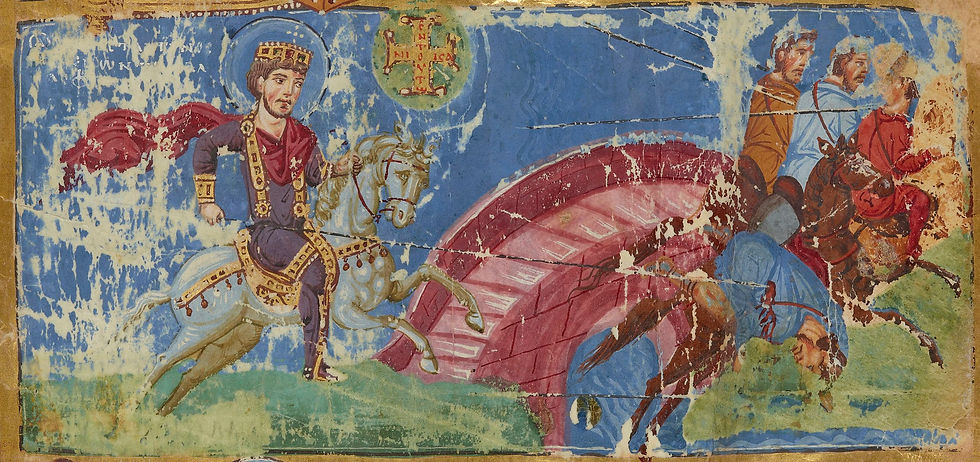SHE WAS MARRIED TO THE BOSPHORUS
- Nila Nmc
- Nov 14, 2020
- 3 min read
Hello to all amazing people out there,
At this moment that I’m writing my very first casual article, I’m sitting behind my desk in a tiny studio based in Birmingham, thousands of miles away from Byzantium! You may know it by other names such as Constantinople and Istanbul too ;)
I’m a byzantinist and a semi archaeologist who has spent a fortune to major in Byzantine studies and do research about it in England. But that’s not the point! The point is, I’ve been in love with Archaeology since I remember. Ancient civilizations have always drawn my attention to the mysterious world behind them. Since I was a child in primary school, I loved visiting museums and archaeological sites. Perhaps because ‘being enthusiastic about History’ runs in my family as my parents love it too.
when I was nine years old, I started off a magnificent journey towards Istanbul together with my parents and that’s how I fell in love with this eternal city in a blink of an eye! it was like love at first sight. years later when I was in high school I went back there again and since then, I’ve been in the capital of Byzantines and Ottomans over six times. In the meanwhile, I was living in Rome, another eternal city, an outdoor museum, chasing my dreams to become an archaeologist. when I set into motion to study Classic and Medieval archaeology, I was more fascinated by the Greek world and mythology but during the second year, when I was taught more medieval materials, I realized I’d love to pursue my studies regarding the Middle ages and what’s better than Byzantine empire! Eastern Roman Empire, where all begins.

Nowadays, when people ask what I’m doing, my answer takes them by either surprise or confusion. The second reaction is more likely to happen because non-specialists don’t know what does “Byzantine'“, this sweet terminology which is like music to my ears means. So, I feel like it’s my duty as a byzantinist to inform you.
First, this is just an academic terminology chosen by historians to divide the eastern Roman world from the western world. In other words, it’d be more explicit to scrutinize the eastern part of the empire in terms of art, archaeology, religion, military, and etc. using this term. However, in reality, Byzantine people considered themselves Romans and even spoke Latin for decades before having Greek as their official language.
second, the foundation of the Byzantine empire didn’t follow the decline of Rome and the western empire. Following this, Constantine the great inaugurated the city Constantinople as the new Rome in 330 A.D while the western world fell apart in 476 A.D.
In the last analysis, the new empire of Constantine adopted Christianity as its official religion while the western Roman world was pagan.
So, these are the main features you need to know to comprehend the sweet term of “Byzantine”. My purpose in creating this blog is to point out all the crucial facts about this very unique empire and look at the byzantine art and history in a fun way. I’ve reached the point that non-specialists in this field, get annoyed with hearing history in a rigid, school-style way so I will be telling stories like mothers tell their children before putting them to sleep. you’d better grab a coffee and spend a short time each week, reading the stories of beloved princesses, golden palaces along the Marmara Sea, churches decorated with colorful mosaics, and even dark streets filled with brothels in the heart of Orthodoxy. I will be telling stories about great generals and military commanders who dedicated their lives to hold out the eastern provinces and conquer the western world for the love of Christ and the throne. I have also stories of their parties, ceremonies, and theaters. the way they used to paint the town red with their traditions.
you can also get drunk with a Mediterranean red wine while I’m bringing the taste of Palestinian and Cypriot wine, the favorite of the imperial court to your house. Furthermore, we’re going to travel together to the markets (forum) and harbors of Golden Horn to buy some fish and meat, using gold and silver coins of the empire that are covered with the pictures of rulers. You can also join me in praying St., Mary and Jesus, on Sunday morning in the Hagia Sofia church, kissing the Icons and reciting the Orthodox bible.
You see! I have stories for everyone. so, grab my hand (virtually;)) and accompany me on this captivating trajectory along the Bosphorus to visit this glistening city between 324-1453 A.D.




You are so talented and I’m proud of you , can’t wait to read your stories. Love you.